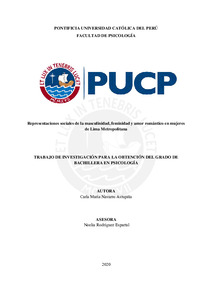| dc.contributor.advisor | Rodríguez Espartal, Noelia | |
| dc.contributor.author | Navarro Astupiña, Carla María | |
| dc.date.accessioned | 2020-11-30T21:47:17Z | |
| dc.date.available | 2020-11-30T21:47:17Z | |
| dc.date.created | 2020 | |
| dc.date.issued | 2020-11-30 | |
| dc.identifier.uri | http://hdl.handle.net/20.500.12404/17589 | |
| dc.description.abstract | La presente investigación se fundamenta en el modelo piramidal multicausal de la violencia de
género de Bosch et al. (2013), teniendo como objetivo explorar las representaciones sociales
de la masculinidad, feminidad y amor romántico en mujeres cisgénero heterosexuales de 18 a
34 años de Lima Metropolitana. Con la finalidad de poder comprender las experiencias y
particularidades de las participantes, se establecieron dos grupos acorde a la etapa de desarrollo:
18 a 25 años y 26 a 34 años. El estudio utilizó una metodología cualitativa con diseño de análisis
temático, el cual permitió identificar categorías y familias que fundamentan las
representaciones sociales de la masculinidad, feminidad y amor romántico en 12 mujeres de 18
a 25 años (N= 6) y de 26 a 34 años (N= 6). Las vivencias de las participantes expresan tener
aún vigente la representación social de la masculinidad hegemónica y feminidad tradicional,
incorporando, a su vez, nuevas características de la modernidad. Se identificó la prevalencia de
los cinco principales mitos del amor romántico como parte estructural de la representación
social del amor romántico, el cual fue acompañado de cuestionamientos debido a experiencias
de sufrimiento en sus relaciones y agentes socializadores. Ambos grupos de participantes
presentan diferentes matices y cuestionamientos según la edad, religión y tiempo en la relación
de pareja, sin desvincularse por completo del núcleo hegemónico de las representaciones
sociales. Por último, se reconoce el modelo piramidal, a partir de la integración de estas tres
representaciones, como fuente de análisis fundamental para comprender y prevenir la violencia
en las relaciones de pareja. | es_ES |
| dc.description.abstract | This research is based on the multi-causal pyramid model of gender violence by Bosch, et al.
(2013), aiming to explore the social representations of masculinity, femininity and romantic
love among cisgender and heterosexual women- 18 to 34 years old- from Lima Metropolitana.
In order to understand the experiences and particularities of the participants, two groups were
established according to their life-span development: 18 to 25 years and 26 to 34 years. The
study used a qualitative methodology with a thematic analysis, which allowed identifying
categories and families that support the social representations of masculinity, femininity and
romantic love in 12 women aged 18 to 25 (N= 6) and 26 to 34 years (N= 6). The experiences
of the participants still express the social representations of hegemonic masculinity and
traditional femininity, incorporating new characteristics of modernity. The prevalence of the
five main myths of romantic love were identified as a structural part of the social representation
of romantic love, which were accompanied by questions because of suffering experiences and
socializing agents. Both groups of participants present different nuances and questions
according to age, religion and time in the couple relationship, without completely
disassociating themselves from the hegemonic nucleus of social representations. Finally, the
pyramid model is recognized, based on the integration of the three representations, as a source
of fundamental analysis to understand and prevent violence in intimate relationships. | es_ES |
| dc.language.iso | spa | es_ES |
| dc.publisher | Pontificia Universidad Católica del Perú | es_ES |
| dc.rights | info:eu-repo/semantics/openAccess | es_ES |
| dc.rights.uri | http://creativecommons.org/licenses/by-nc/2.5/pe/ | * |
| dc.subject | Masculinidad | es_ES |
| dc.subject | Feminidad | es_ES |
| dc.subject | Amor--Aspectos psicológicos | es_ES |
| dc.subject | Mujeres--Perú--Lima | es_ES |
| dc.subject | Representaciones sociales | es_ES |
| dc.title | Representaciones sociales de la masculinidad, feminidad y amor romántico en mujeres de Lima Metropolitana | es_ES |
| dc.type | info:eu-repo/semantics/bachelorThesis | es_ES |
| thesis.degree.name | Bachiller en Psicología | es_ES |
| thesis.degree.level | Bachillerato | es_ES |
| thesis.degree.grantor | Pontificia Universidad Católica del Perú. Facultad de Psicología | es_ES |
| thesis.degree.discipline | Psicología | es_ES |
| renati.advisor.cext | 1296115 | |
| renati.advisor.orcid | https://orcid.org/0000-0001-8540-241X | es_ES |
| renati.discipline | 313016 | es_ES |
| renati.level | https://purl.org/pe-repo/renati/level#bachiller | es_ES |
| renati.type | https://purl.org/pe-repo/renati/type#trabajoDeInvestigacion | es_ES |
| dc.publisher.country | PE | es_ES |
| dc.subject.ocde | http://purl.org/pe-repo/ocde/ford#5.01.00 | es_ES |






